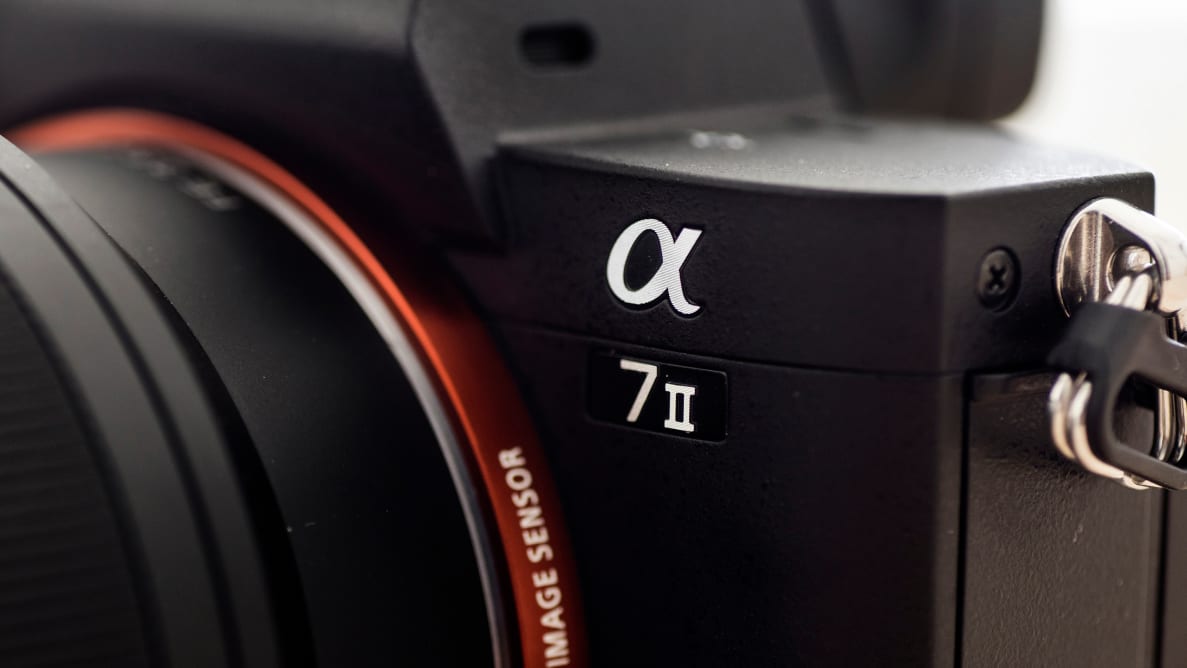The three original models gave shooters that silky full-frame aesthetic, but there was plenty of room for improvement. Handling was a notable weak point on all the A7 bodies, with all three plagued by autofocus issues to some degree. The result was more first draft than finished product.
Debuting late last year, the new Sony Alpha A7 II (MSRP $1,699.99) sands down some of the rougher edges of the previous generation. It also ships with a brand-new, five-axis in-body image stabilization system, letting the A7 II stabilize any lens you mount onto its body—native or otherwise. It's inarguably a better camera. But with several key issues left unresolved, is it time to jump on the full-frame mirrorless bandwagon, or is it worth holding out a little longer?
Design & Handling
Grip gripes are gone for good
As much as we liked the look of the original A7 cameras, ergonomics too often seemed to play second fiddle to design. Striking though they may have been, the first three versions of the A7 strove for retro appeal more than usability. The problem is that, as a full-frame camera, the A7 platform is expected to toe-to-toe with some beefy DSLRs, requiring bigger lenses that can cover the full-frame sensor.
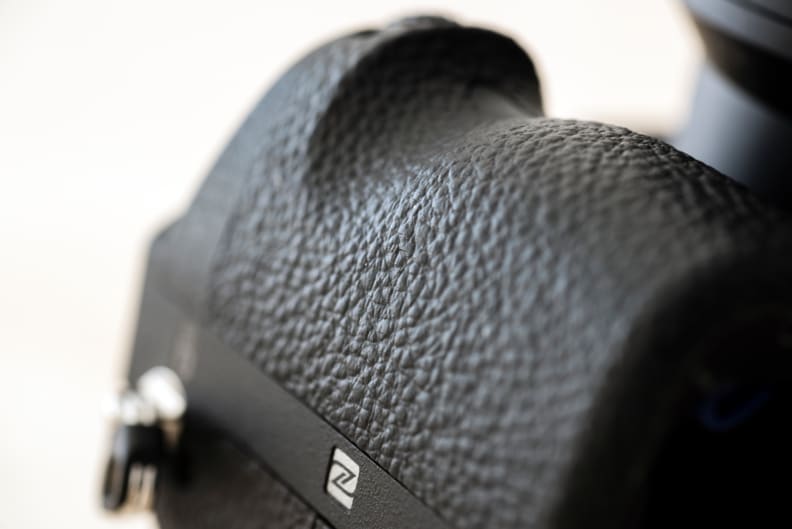
The new grip also features NFC inside it.
Thankfully, the A7 II puts its intentions front and off-center. Gone is the wimpy bump of grip from the original A7, and here to stay is a larger grip that is more reminiscent of Sony's excellent NEX-7. It makes the camera so much easier to hold on to, allowing a relatively small camera to balance more effectively, even with bigger lenses. The shutter button, power switch, and front control dial all make their new home on this peninsula of rubber, and A7 II is far better off because of it.
While the new front and rear control dials are a vast improvement over the strange, hard-to-reach controls on the first A7 cameras, we still can't say we love the way the shutter button feels. It has a shallow half-press and a gummy, indistinct stopping point.
With the FE 55mm f/1.8 lens mounted, the camera was light and effortless to carry around. I traveled with it on several cross-country trips and didn't mind just leaving it in my bag. We're also big fans of the A7 II's rugged-looking hammer tone finish, which seems like it'll show less scratches over time than the satin finish of the original A7 trio.
{{ photo_gallery "tour" }}
The rest of the A7 II is pretty standard for Sony, with a rear control dial, tilting rear screen, vertical control dial, and two top-mounted dials for exposure compensation and modes. One thing that advanced shooters will appreciate is the inclusion of more custom function buttons, totaling four this time around. Though hardly groundbreaking, Sony has also bumped the rear LCD's resolution from 921k dots to 1.2 million.
Altogether, the changes—especially to handling—make perfect sense; it's a wonder that the larger grip wasn't included already. It's still way smaller than cameras like the Canon 5D Mark III or Nikon D610, yet image quality is still easily on par. Performance aside, if you're sick of lugging around a full-frame DSLR the A7 II is a welcome reprieve.
Probably the one area that needs a notable improvement is the interface. Even though the most important settings are quickly brought to the forefront with the Fn menu, there's too much that requires you to fiddle about in a menu. Nikon's menu system isn't much better, but if you're used to a newer high-end Canon such as the 5D Mark III, EOS-1D X, or 7D Mark II then this will simply require a lot more trips to the menu.
Perhaps most importantly, though, is that nothing here feels like a step backwards. Everything from the grip, to the new matte finish, to the new custom button layout enhance the A7 concept in minor but overall excellent ways. It's a positive that Sony is willing to make changes so soon, but it's refreshing to see their designers avoid change for its own sake.
Features
With a new co-star, the full-frame sensor shares the spotlight.
Undoubtedly, the biggest draw of the A7 II is its 24-megapixel full-frame sensor. With a lens system that's still quite a ways behind Panasonic, Olympus, Canon, Nikon, and even Fujifilm, it's the best reason to opt for Sony's fledgling system. But there's another reason why this camera deserves your attention—its advanced in-body five-axis image stabilization system.
Of course, we've seen five-axis sensor-shift based systems in cameras like the Olympus OM-D E-M1 before. What's truly impressive here is that Sony is able to stabilize such a large imaging stack without (further) killing battery life and while keeping the camera relatively compact. Though our time indicates that Sony's system isn't quite as good as Olympus's, those are impressive achievements regardless.
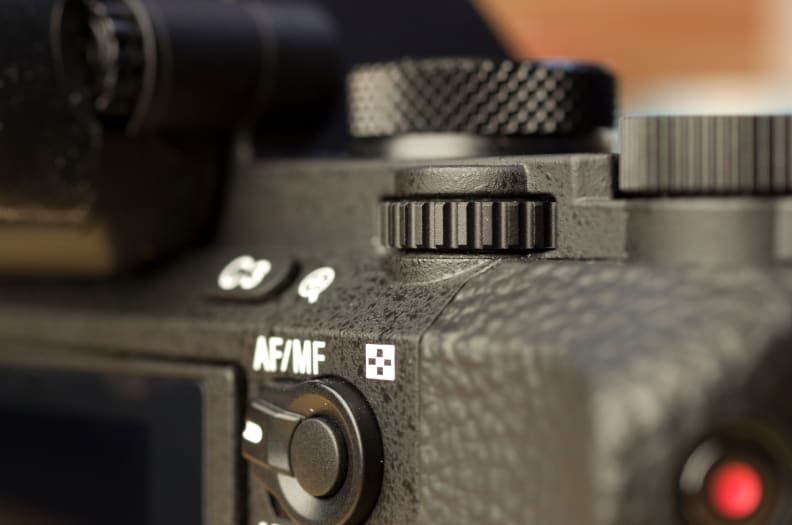
Easier to reach control dials are a small change that makes a big difference.
Other than that, there isn't a whole lot that's "new" in the A7 II. The A7 was already packed with Sony's best imaging technology, so that's hardly a cause for concern. The sensor in the A7 II once again has phase-detection pixels onboard, which better tracks motion and is intended to complement the camera's contrast detection autofocus system. The only thing we have to note is that low-light AF continues to be very hit-or-miss. Focus peaking can help tremendously, though, and with the built-in EVF it's easy enough to employ your own eyes in dim settings.
{{ photo_gallery name="design" }}
For those willing to put up with its quirks, the A7 II is once again an intriguing video option due to its new XAVC S codec. The original A7 couldn't manage to output video in this format, as it didn't roll out until the 4K-capable A7S hit shelves. The A7 II can't record 4K, but the superior compression of the XAVC S format is a welcome improvement over the old AVCHD standard.
That said, if you don't need full-frame angle of view or depth of field, the Panasonic Lumix GH4 handily beats it. The GH4 records superb 4K and 1080p footage, with full manual control, wonderful color reproduction, and a surprising amount of dynamic range from a relatively small sensor.
FE Mount
Sony's chicken-and-egg problem
When Sony entered the mirrorless camera market in 2010, its original E-mount-based cameras sported the smaller-sized APS-C imaging sensor. It's the same kind of sensor you'd find in an entry-level DSLR. The A7 II uses the same mount, but lenses that will cover the full-frame image sensor are still scarce. You can use Sony's back catalog of APS-C lenses, but given the A7's main appeal is its full-frame sensor, that isn't exactly a stellar option.
Sony's roadmap shows as many as 20 lenses by the end of this year, though we're not holding our breath. That's more aggressive than what we saw last year, but Sony's been making grand promises about lens selection for years. Either way, at the moment the FE mount simply doesn't keep up with well-worn professional systems like Canon's EF and Nikon's F-mount. Even Ricoh, which should be launching a full-frame Pentax DSLR later this year, will have at least 11 compatible lenses day-one. FE isn't there yet, unless you're willing to think outside the box.

Sony is on the absolute top of its sensor game right now.
The workaround involves using adapted lenses. The A7 II is the perfect Swiss Army camera, capable of using legacy film lenses from any system out there. Since Sony designed the lens mount to have a very short flange focal distance, it's possible to add a dumb, cheap metal adapter that can mate to the lens mount of your choice. This gives you access to a world of awesome glass that is often just collecting dust in someone's garage. While autofocus won't work with these dumb adapters, you do get focus peaking, a beautiful EVF, and five-axis stabilization—all things these lenses never enjoyed in their first lives.
Sony also provides some backwards compatibility through its legacy A-mount lenses using its own first-party adapters. There are some worthwhile holdovers from the Konica Minolta days (which Sony purchased). If you opt for Sony's LA-EA4 adapter you even get a built-in phase-detect autofocus system. It adds some bulk, but it quadruples your lens options overnight.
Performance
On par with its brethren
If there was one thing we were expecting from the Sony A7 II, it was improved performance. It appears that Sony's addressed some of the issues we had with the past A7 generation, but, in our opinion, there's still some work to be done. The camera world marched ahead very quickly in 2014, and the A7 II, in a few ways, feels like it's stuck in 2013.
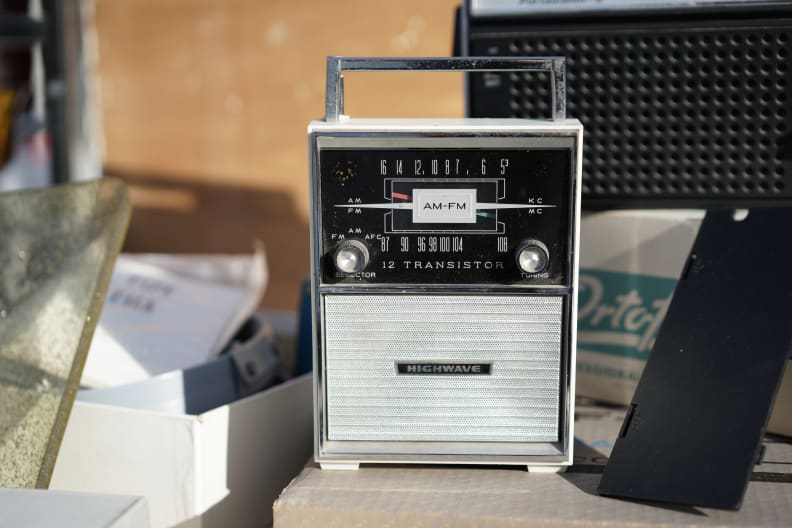
Since the A7 II is based around a very similar sensor and processor combination to what Sony has employed in the previous A7, we weren't surprised to get excellent performance results. This 24-megapixel sensor is in the sweet spot between the 36-megapixel A7R and the super-sensitive 12-megapixel sensor from the A7S. It cuts a nice balance between the two, with the added benefit of phase-detect autofocus pixels baked right in.
This hybrid autofocus system makes the A7 II the fastest horse in Sony's stable, and that's partly thanks to improved software, too. The new autofocus system is derived from the super-speedy Sony Alpha A6000. We're hesitant to say that the A7 II is that camera's equal when it comes to speed and accuracy, though; there were moments when the A7 II felt unsure, hunting at the very last, while in bright light it just isn't as zippy as the Olympus OM-D E-M1 or Fujifilm X-T1.
{{ photo_gallery "sample-photos" }}
The A7 II's two greatest sins are, unfortunately, inherited from its predecessor. The first is the A7 II's slow power-up time. When completely off, or asleep, it takes way longer than a competing DSLR to boot up. And if you turn off auto-sleep, you're in an even worse spot, as the battery drains in seemingly no time. The new image stabilization system might not make the battery life worse than the A7, but it still drains while you watch. The CIPA rating isn't so shabby at 350 shots, but in our experience, those shots come and go extremely fast.
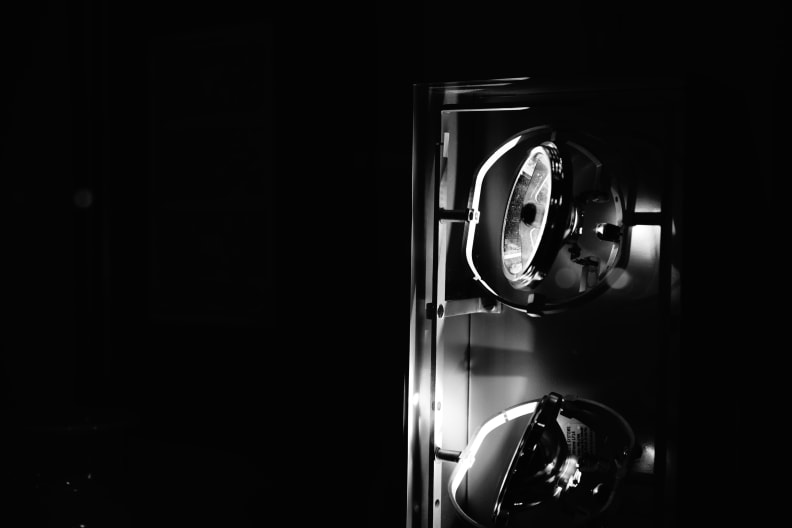
These two shortcomings put you between a rock and a hard place, and continue to underscore the developmental difference between this and its full-frame DSLR competition. Mirrorless cameras like the A7 II might be the future, but we're still not there...yet.
Conclusion
Hello, is it the A7 II you were looking for?
If you were expecting the A7 II to be a revolutionary update, we understand if it feels underwhelming. On the outside, not much appears to have changed. But while it doesn't distance itself from its predecessors, it's a steady step forward for a system that's still finding its legs.
That's an important point to keep in mind, because while mirrorless systems from Olympus, Panasonic, Fuji, and even Samsung seem to be rounding into form, Sony's still in the middle of a rather awkward pivot toward full-frame. Even though Sony's been producing mirrorless cameras for almost five years now, the FE mount is still quite young, with a lack of lenses and all the quirks that come with this kind of transition.
This may be a more refined version of the original A7, but it's still a camera for early adopters willing to look past its flaws. Personally, my time with the camera was memorable. It quickly reminded me how nice shooting with a full-frame camera can be. It opens up a wealth of options if you're willing to consider adapting old lenses, with a manual focus system that complemented my slower, deliberate shooting style.
Traveling with it for a couple of weeks was painless (try saying that about a Nikon D810), with the limited battery life offset by the A7 II's compatibility with standard Micro-USB chargers. More than anything, I was struck by just how effective the stabilization is; my overly caffeinated hands were simply no match for it. The 5-axis Inside SteadyShot system is like the second half of a buddy comedy—the Griggs to the sensor's Murtaugh, if you will. Together, they make the A7 II a lethal photographic weapon.
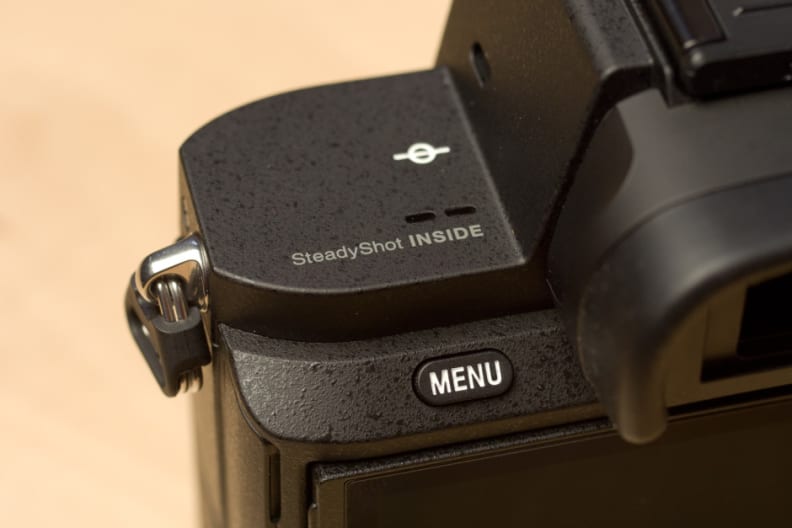
The A7 II's biggest new feature is in-body image stabilization.
If you're dead set on getting a full-frame camera this small, the A7 II's only real competition is its predecessor, which can be had for roughly $1,300 these days but lacks the 5-axis stabilization. Your other alternatives are either bulkier full-frame cameras like the $1,500 Nikon D610, or other mirrorless cameras with smaller sensors like the $1,300 OM-D E-M1 or $1,200 Fujifilm X-T1.
That unique position sets the A7 II apart, even if its system doesn't yet feel as mature as its competition. Still, after spending plenty of time with it, those are forgivable sins. Like an old fixer-upper, the bones are here for a wonderful system that marries old-school charm with modern convenience. You'll have to peek past the chipped paint, and pardon Sony's dust, but before long this system could be the envy of the whole block.
By the Numbers
Given its pedigree, the A7 II brings a lot to the table. We ran this new iteration of Sony's full-frame mirrorless recipe through our labs, and the science bore out initial suspicions. The A7 II easily acquits its price nicely, except for a couple of missing features in the video category. And, moreover, the Sony software continues to aggressively crush detail with its high ISO noise reduction.
Color & White Balance
In our color tests, the A7 II did about as well as its FE-mount siblings. With its built-in JPEG engine tuned to please a bunch of different users, we found that the most accurate mode is its Standard mode. Of course, these modes don't apply to the camera's RAW shooting modes, but, since it has WiFi, we found the color modes to be a great way of doing in-camera edits for sharing over social media. The most accurate color mode we tested is the camera's standard mode, with a ∆C 00 Corrected of 2.33 and a saturation of just underneath our ideal, at 99.5%. We've also found that Sony's Deep color mode is very accurate, at least in past Alpha offerings.
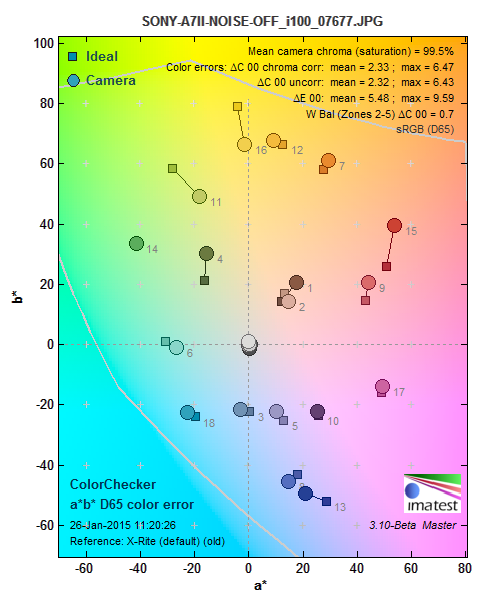
When we tested it for white balance, we found that the A7 II did a decent enough job at recognizing the three main scenes we use in our test. Like many of its competitors, the A7 II found the tungsten/incandescent lighting scenario the most challenging, showing a noticeable cast on our sample photos. For the best results, set you own custom white balance when you're shooting under incandescent lights.
Noise
Sony's advanced mirrorless options are some of the best out there, but we generally find the noise reduction algorithm that Sony utilizes to be a little over the top. With this 24-megapixel sensor, you get very decent latitude up until high ISOs. That's when we found that Sony's default noise settings aggressively destroys chroma noise, crushing fine detail right along with it.
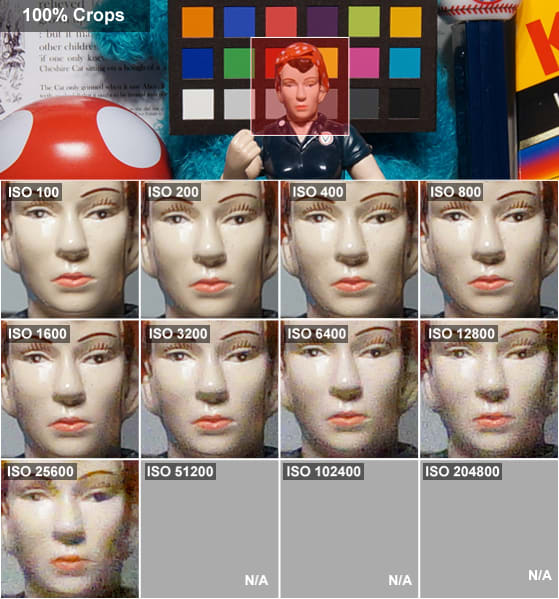
With the standard high ISO noise reduction settings turned on, we saw that images cross the 2% noise threshold at ISO 6400, whereas with no noise reduction applied, images will get past 2% between 1600 and 3200. In regular shooting, we preferred to keep the A7 II's auto ISO range limited to top out around ISO 800, bumping it up to 1600 when needed. Thankfully, the camera's new image stabilization system really picks up the slack here, meaning you can shoot at a lower ISO than you could without IBIS.
Resolution
In our standard resolution test, the Sony A7 II passed with flying colors. Sony's on the top of its sensor game, and the 24-megapixel full-frame chip inside the A7 II is just as good as the one we saw in the original A7.
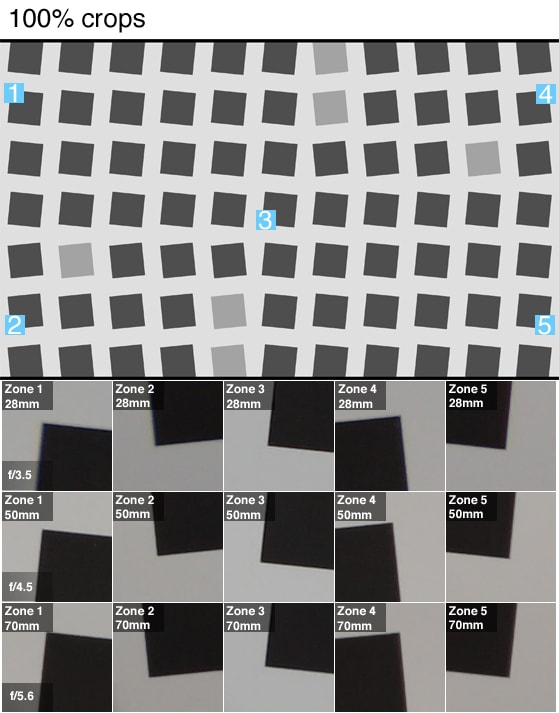
We tested the A7 II with its kit lens, the FE 24-70mm f/3.5-5.6 OSS. While it isn't the greatest kit lens we've ever used, it's a very decent option for the beginner, with quick autofocus. We saw very little in the way of chromatic aberration from this kit lens. Granted, it's a bit soft at full wide and at f/3.5, but stop it down a bit and the results should improve.
Video
We've been spoiled by so many great modern still cameras that are also great at video. With the A7 II, Sony's put some pretty great video features in an already capable cameras, but it's missing a couple that we'd like to see in the future.
Using this camera's new XAVC S codec, we eked plenty of HD video content out of the A7 II. In our bright light scenario, we saw numbers of 700 LP/PH horizontal and 725 LP/PH vertical. Thanks to its full-frame sensor, the A7 II held it together in low light, resolving 550 LP/PH horizontal and 600 LP/PH vertical. In our low light sensitivity test, we only needed 5 lux to get a picture at 50 IRE, which is about as good as the other Sony A7 cameras we've seen, save for the über-sensitive A7S.
Perhaps the biggest shortcoming of the A7 II is its lack of 4K recording, either to a card or even via clean HDMI out. Sony has reserved that feature for the A7S, but since last year's Panasonic Lumix GH4 hit the scene, we've been waiting for another camera manufacturer to truly rival. As it stands, you'll be able to use an external recorder to nab uncompressed 1080/60p at 4:2:2 with 8-bit color, but that's as good as it gets for this little camera.
Meet the tester
Brendan is originally from California. Prior to writing for Reviewed.com, he graduated from UC Santa Cruz and did IT support and wrote for a technology blog in the mythical Silicon Valley. Brendan enjoys history, Marx Brothers films, Vietnamese food, cars, and laughing loudly.
Checking our work.
Our team is here to help you buy the best stuff and love what you own. Our writers, editors, and experts obsess over the products we cover to make sure you're confident and satisfied. Have a different opinion about something we recommend? Email us and we'll compare notes.
Shoot us an email
